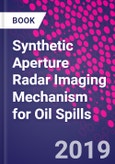Synthetic Aperture Radar Imaging Mechanism for Oil Spills delivers the critical tool needed to understand the latest technology in radar imaging of oil spills, particularly microwave radar as a main source to understand analysis and applications in the field of marine pollution. Filling the gap between modern physics quantum theory and applications of radar imaging of oil spills, this reference is packed with technical details associated with the potentiality of synthetic aperture radar (SAR) and the key methods used to extract the value-added information necessary, such as location, size, perimeter and chemical details of the oil slick from SAR measurements.
Rounding out with practical simulation trajectory movements of oil spills using radar images, this book brings an effective new source of technology and applications for today's oil and marine pollution engineers.
Please Note: This is an On Demand product, delivery may take up to 11 working days after payment has been received.
Table of Contents
1. Quantum of oil spill2. Principles of maxwell's equations3. Quantization of maxwell's equations4. Quantum description of twisted electromagnetic wave propagation5. Quantized of scattering theory6. Quantum description of sea surface7. Quantum of radar theory8. Principle theories of synthetic aperture radar9. Quantum theory for imaging oil spill from synthetic aperture radar10. Principles of genetic algorithm11. Automatic detection of oil spill from sar satellite data using genetic algorithm12. Multi-objective evolutionary algorithm for monitoring oil spill spreading level 13. Quantum immune fast spectral clustering for automatic detection of oil spill14. Four-dimensional hologram interferometry for oil spill automatic detection
Authors
Maged Marghany Professor, Department of Informatics, Faculty of Mathematics and Natural Sciences, Universitas Syiah Kuala Darussalam, Banda Aceh, Indonesia. Maged Marghany is currently a Professor at the Department of Informatics, Faculty of Mathematics and Natural Sciences, Universitas Syiah Kuala Darussalam, Banda Aceh, Indonesia. In 2020 he was ranked amongst the top 2 percent of scientists in a global list compiled by the prestigious Stanford University. He is author of 5 titles including: Advanced Remote Sensing Technology for Tsunami Modelling and Forecasting which is published by Routledge Taylor and Francis Group,CRC and Synthetic Aperture Radar Imaging Mechanism for Oil Spills, which is published by Elsevier,His research specializes in microwave remote sensing and remote sensing for mineralogy detection and mapping. Previously, he worked as a Deputy Director in Research and Development at the Institute of Geospatial Science and Technology and the Department of Remote Sensing, both at Universiti Teknologi Malaysia. Maged has earned many degrees including a post-doctoral in radar remote sensing from the International Institute for Aerospace Survey and Earth Sciences, a PhD in environmental remote sensing from the Universiti Putra Malaysia, a Master of Science in physical oceanography from the University Pertanian Malaysia, general and special diploma of Education and a Bachelor of Science in physical oceanography from the University of Alexandria in Egypt. Maged has published well over 250 papers in international conferences and journals and is active in International Geoinformatic, and the International Society for Photogrammetry and Remote Sensing (ISPRS).








